Montessori From the Start: Day 4
The Toddler Work Nook
“Imitation is the first instinct of the awakening mind.”
– Maria Montessori
Setting up a workshelf for your toddler in a central place in the home is the first step to creating a prepared environment in which your child can learn freely. However, the Montessori at Home approach sees the entire home as your child’s first classroom.
Anyone with a toddler knows that most often they want to be right where we are, getting into whatever work it is we are trying to accomplish. Many parents ask me, “How do I get my toddler to sit with something so I can actually clean up breakfast, do the laundry, write an email?” The answer to this is to shift from thinking of toys, games or screens to keep your child occupied, but rather to involve them meaningfully in the work of the home. By watching and doing along side you they are able to build vital skills of independence and self-confidence.
Guided by the Montessori-at-Home approach, I began considering each part of my home and the important work that happened there. Once my son was fully walking and free to follow me and assist with his own hands (around 15 months), we created a small space in each room where he could get involved in child-sized versions of that work.
Keep in mind, we live in a Brooklyn apartment and space is limited! These little work nooks can be fit into even the most compact home.
The Entryway
As soon as you enter the home there can be a place for your child to participate in removing their shoes, hat and coat and putting them away. A coat rack mounted at the child’s level is perfect and will serve them for years to come.
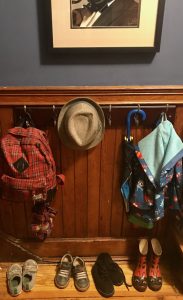 While every household has their own way, washing the hands upon arriving home is the proven way to keep germs out. Most sicknesses enter our homes on our hands and good old fashioned soap and warm water is still the best way to prevent the spread. A simple handwashing station by the door includes a basin and pitcher, soap and paper towels. While your child puts away their shoes you can fill the pitcher with warm water and model how to wash hands together. This is especially useful for playdates with other parents and children!
While every household has their own way, washing the hands upon arriving home is the proven way to keep germs out. Most sicknesses enter our homes on our hands and good old fashioned soap and warm water is still the best way to prevent the spread. A simple handwashing station by the door includes a basin and pitcher, soap and paper towels. While your child puts away their shoes you can fill the pitcher with warm water and model how to wash hands together. This is especially useful for playdates with other parents and children!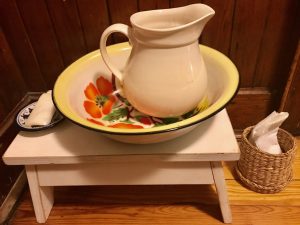
The Kitchen
The kitchen is the heart of the home! At 15 months we got some space from the ever present sippy cup and began supporting our son to pour his own water at a low water pouring station when he was thirsty. Remember to provide a tray, a towel – and I recommend a child sized mop! Water will spill, and cleaning up is a part of the process. (You’ll note our tray got a bit rusty!)
You can also serve snack at this table. A small broom should be provided for cleaning up crumbs. As your child grows he or she can participate in preparing and cleaning up snack – slicing bananas with an egg slicer, spreading nut butter on crackers with a child-sized butter knife and clearing dishes when finished.
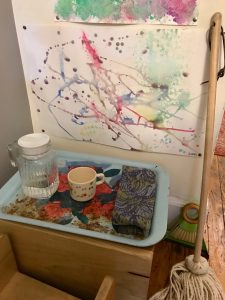
We all know the challenge of cooking meals and cleaning up with a toddler at our feet, pulling items out of the cabinets! While I do recommend leaving a low cabinet or drawer with safe materials for this exploration, a child-sized cooking station is a wonderful way to allow children to mimic us in the kitchen when they are not quite ready to actually join in.
Shown below are a set of IKEA cloth vegetables, Melissa and Doug pots, pans and cooking utensils and child-sized cleaning items. These have served us for years! On the right is a large basin and “splat mat” which can be spread out so children can help with simple food prep and clean up such as scrubbing a potato or two, rinsing vegetables or washing a few dishes.
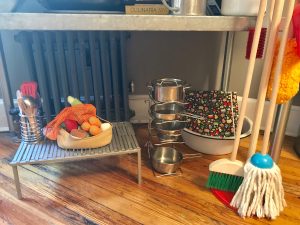
The Office
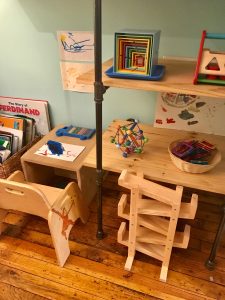
As an educational therapist, I did a significant amount of work from home all the way through my son’s toddler years. Setting up a corner with a low table and table-top work, including crayons, sensory materials and books, helped us both to engage in quiet work when I needed time on my computer. As children grow older they can be encouraged to spend more time at a desk and build their focus for fine motor activities. Especially if your child attends a Montessori school you will see them engaging in seated work for longer and longer periods.
The Bathroom
Very important work can begin in the bathroom around 15 months…yes, in the Montessori at Home approach this is when potty training starts. The first step is of course the prepared environment. A potty, accessible wipes and some good reading material is all you need. When you would normally change your child’s diaper, begin encouraging some potty time. Sitting to read a book (we adored Potty by Leslie Patricelli) and modeling the process for your child makes the learning curve natural and even enjoyable. My son loved to sit and flip through books for up to a half hour at a time and the warm celebration he got for putting something in the potty provided all the motivation he needed to be fully potty trained – yes, in undies overnight – by age 2.

Multi Use Spaces
Then there are all the other things we hope to accomplish while parenting a toddler…a workout, laundry, a random household task that pops up. Here are a few ideas for these spaces. 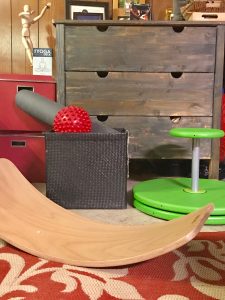
Exercise does not have to end just because you have a toddler at home! In fact, working out together has always been one of my favorite activities with my son. I keep a child-sized yoga mat, balls and some big gross motor works in the downstairs den. Shown is a Waldorf balance board and the Whizzy Dizzy.
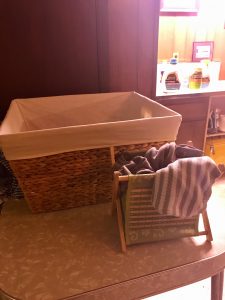
A child-sized laundry basket can be filled with some of your child’s clothes so they can participate in loading the machine or folding alongside you.
 Finally, I can’t say enough about simply finding a spare drawer, cabinet or shelves in every room to place a revolving hands-on activity. This allows for simple redirection to safe and purposeful activity wherever you and your child might be at home!
Finally, I can’t say enough about simply finding a spare drawer, cabinet or shelves in every room to place a revolving hands-on activity. This allows for simple redirection to safe and purposeful activity wherever you and your child might be at home!
